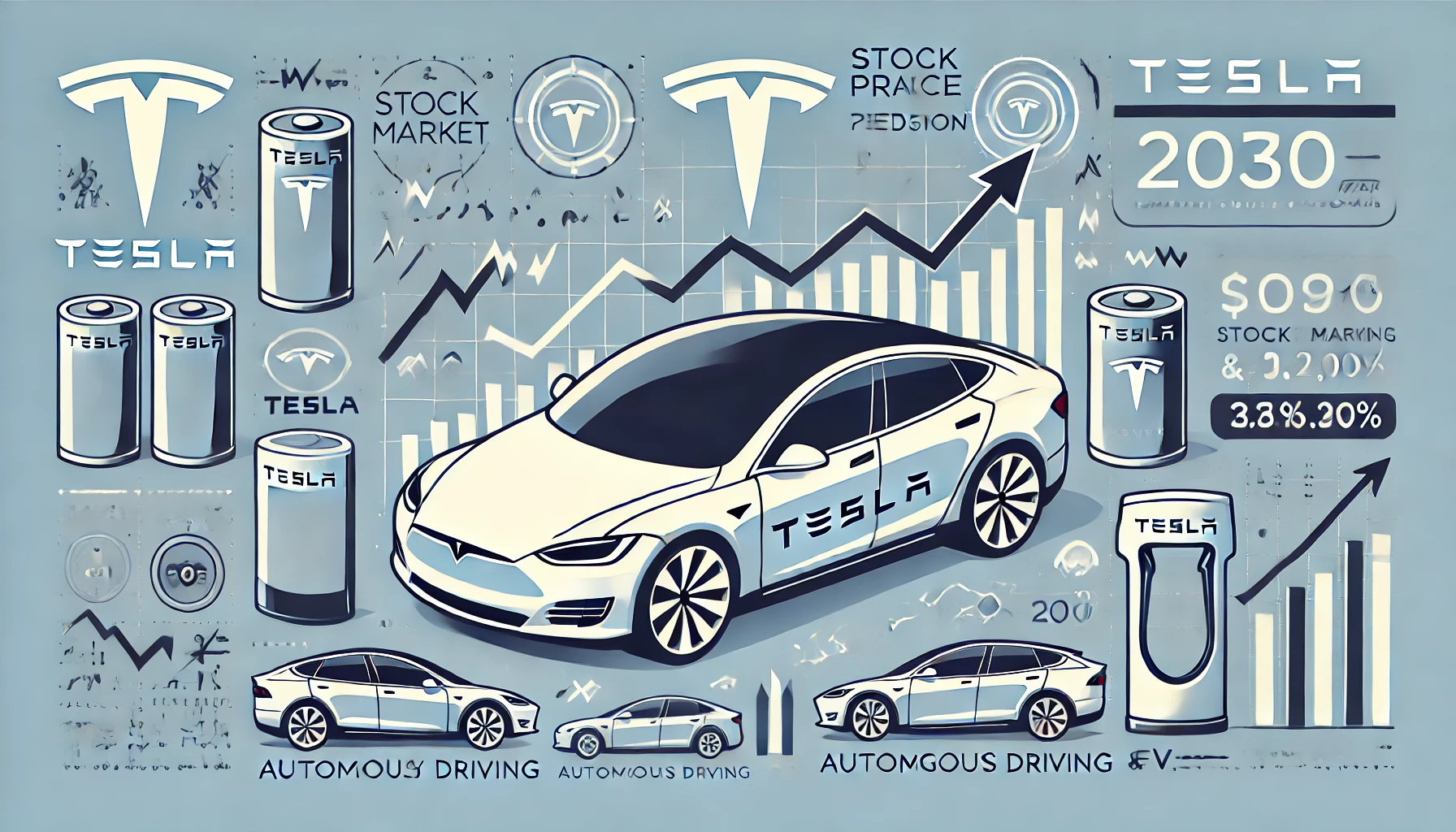Your cart is currently empty!
Tesla Stock Price Prediction for 2030

Tesla, Inc. (TSLA) has been a focal point of investor interest for over a decade, thanks to its disruptive approach to the automotive industry, groundbreaking innovations in electric vehicles (EVs), and ambitious ventures into energy storage, AI, and autonomous driving. With Tesla’s rapid growth and market leadership, long-term price predictions for its stock have become a hot topic, especially with the 2030 horizon in sight. This article delves into various factors that could shape Tesla’s stock price by 2030, along with expert predictions and market trends.
1. Tesla’s Current Market Position
As of 2024, Tesla remains the dominant player in the electric vehicle (EV) market, having delivered over 1.8 million vehicles in 2023. The company’s impressive growth is underpinned by its Gigafactories across the globe, enabling Tesla to scale production at a rapid pace. Moreover, Tesla is not just an automaker; it is also a leader in battery technology, energy storage, and solar energy solutions. Elon Musk’s vision for a fully sustainable energy ecosystem has bolstered investor confidence in Tesla’s long-term growth prospects.
Tesla’s stock price is known for its volatility, reflecting the company’s aggressive expansion strategies and the market’s high expectations. At the time of writing, Tesla’s stock hovers around $250 to $300 per share, with a market capitalization of over $750 billion. Despite occasional setbacks due to production challenges or macroeconomic factors, Tesla has shown resilience, often rebounding stronger after dips.
2. Factors Influencing Tesla’s Stock Price by 2030
Several key factors will drive Tesla’s stock price by 2030, many of which are directly tied to the company’s ability to innovate and execute its ambitious plans.
a. Global Electric Vehicle (EV) Adoption
EV adoption is expected to accelerate dramatically over the next decade. By 2030, EVs could account for 40% or more of global car sales, with Tesla well-positioned to capture a significant share of this market. As traditional automakers like General Motors, Ford, and Volkswagen ramp up their EV offerings, Tesla will face increased competition, but its first-mover advantage, strong brand recognition, and technological leadership in battery efficiency and autonomous driving should allow it to maintain a dominant position.
b. Battery Technology and Energy Storage
Tesla’s leadership in battery technology is another critical growth driver. By 2030, advancements in battery efficiency, cost reduction, and recycling could significantly enhance Tesla’s margins. The company’s ability to scale its battery production, particularly through its Gigafactories, will be vital. Tesla’s foray into energy storage solutions, such as the Powerwall and Powerpack, also provides diversification beyond automotive. As renewable energy adoption grows, demand for energy storage will likely follow, creating additional revenue streams for Tesla.
c. Autonomous Driving
Tesla’s Autopilot and Full Self-Driving (FSD) technology are major components of its future growth narrative. Elon Musk has long predicted that Tesla will achieve full autonomy, which could potentially open up entirely new business models for the company, such as robot taxis. If Tesla is successful in bringing fully autonomous vehicles to market by 2030, it could revolutionize the transportation industry, significantly boosting Tesla’s valuation.
d. Expansion into New Markets
Tesla’s future growth may also come from expanding into emerging markets like India, Africa, and Southeast Asia, where EV penetration remains low. Establishing manufacturing facilities and scaling operations in these regions could unlock new revenue streams and enhance Tesla’s global footprint. In addition, Tesla’s entry into new product categories, such as the Cyber track and electric semi-trucks, adds to its long-term growth potential.
e. Regulatory and Environmental Factors
Global regulatory shifts toward reducing carbon emissions will likely benefit Tesla. As governments worldwide tighten emissions standards and incentivize EV adoption, Tesla stands to gain from both consumer demand and favorable policies. Environmental regulations could also pressure competitors, giving Tesla a further edge(
3. Stock Price Predictions for 2030
Predictions for Tesla’s stock price by 2030 vary widely among analysts, but most are bullish on the company’s prospects given its leadership in key industries. Below are some expert forecasts:
Bullish Scenario: In an optimistic scenario where Tesla captures a significant portion of the global EV market, achieves breakthroughs in battery technology, and rolls out autonomous driving, analysts predict Tesla’s stock could exceed $2,500 to $3,000 per share by 2030. This estimate assumes Tesla’s revenue and profitability continue to scale, with margins improving through cost efficiencies and technological advancements.
Moderate Scenario: In a more conservative outlook, where Tesla continues to grow but faces increased competition and regulatory challenges, analysts predict Tesla’s stock price could range between $1,500 and $2,000 per share. This scenario assumes steady growth in EV adoption but with more pressure on pricing and margins due to competitive forces.
Bearish Scenario: In a less favorable case, where Tesla encounters significant production challenges, delays in autonomous driving, or macroeconomic headwinds, Tesla’s stock could still see moderate growth, potentially reaching $1,000 to $1,200 per share. This scenario hinges on slower-than-expected market penetration and technological development.
4. Risks and Challenges
While Tesla has a strong growth trajectory, several risks could impact its stock price by 2030:
Supply Chain Disruptions: Ongoing supply chain issues, particularly in sourcing key materials for batteries, could slow Tesla’s production capabilities.
Increased Competition: Traditional automakers are rapidly catching up with Tesla, and newer entrants to the EV market could pressure Tesla’s market share.
Technological Hurdles: While autonomous driving promises significant growth, regulatory approvals and technological challenges could delay Tesla’s progress in this area.
Conclusion
Tesla’s stock price prediction for 2030 is highly dependent on several factors, including global EV adoption, battery technology advancements, autonomous driving capabilities, and successful market expansions. While risks remain, the company’s position as a leader in EVs, energy storage, and clean technology gives it a strong foundation for future growth. Whether Tesla will reach the optimistic predictions of $3,000 per share or fall short due to competition and regulatory hurdles remains to be seen, but its long-term potential continues to excite investors.
For those looking to capitalize on the future of Tesla, staying informed about market trends and using expert tools like those offered by rajeevprakash.com can help guide investment decisions in this rapidly evolving sector.

Mr. Rajeev Prakash
Rajeev is a well-known astrologer based in central India who has a deep understanding of both personal and mundane astrology. His team has been closely monitoring the movements of various global financial markets, including equities, precious metals, currency pairs, yields, and treasury bonds.
